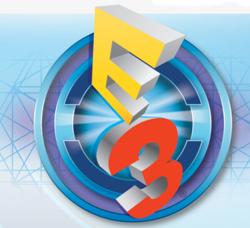
by Lidia Paulinska | May 30, 2016
Just two more weeks until the Electronic Entertainment Expo (E3), the world’s premiere trade show for computer and video games, that is being held at the LA Convention Center. More than 20,000 attendees are expected, many new products and announcements but also for the first time the fans and enthusiasts of the electronic entertainment can be a part of that exciting event. E3 Live will be situated at Downtown Los Angeles’ sports and entertainment district of the city and will be open to the ticketed public.
E3 and E3 Live will be taking place from Tuesday, June 14 till Thursday, June 16. Before the doors open for the show let get a glimpse at the state of the industry.
Games industry is the fastest growing sector of the modern entertainment industry and is part of modern culture. Today game enthusiasts expect a richer, fuller and more involving game experience. Under such demanding clientele, more dynamic and multidirectional developments of games have been created, and the pallets of emotions both in the game and experienced by the player, have been greatly increased. Production studios strive for authenticity and put meticulous attention to detail, bringing players into a new level of realism, which may include 3D technology that changes flat images to three-dimensional images and cinematic quality photo-realistic events. Today’s game has a story line, utilizes state of the art visual graphics and utilizes new, advanced form of interaction with the player. In addition there is also increased proliferation of artists in the games industry, who get to express themselves creatively and individually. The impact of the games on mass culture is unquestionable and its value is growing at a dynamic pace.
The big attraction this year is the realization of the hype created by the Virtual Reality (VR) products. Not only is VR in a number of new platforms from companies like Oculus, Sony, Samsung, Razer, HTC and others, but the show will feature a full VR ecosystem. Accessories for controlling the game, walking around and being fully physically immersed in the game, new sensors, games from major publishers and companies as well new experiences from independent developers.
The other major attraction at the show is the availability of accessories and peripherals for the new consoles and high performance PCs released in the past couple of years. The accessories – charging devices, extension cables, headphones, and controllers, performance accessories such as CPU & memory coolers, and skins /decorative items take a little bit to develop after the platforms are released, as they require the software titles to make their market entry before the user community makes the commitment to adopt the large variety of branded items.
The industry topped $131B USD in sales covering the hardware, software and accessories marketplace.

More info at http://www.e3expo.com/url_takeover
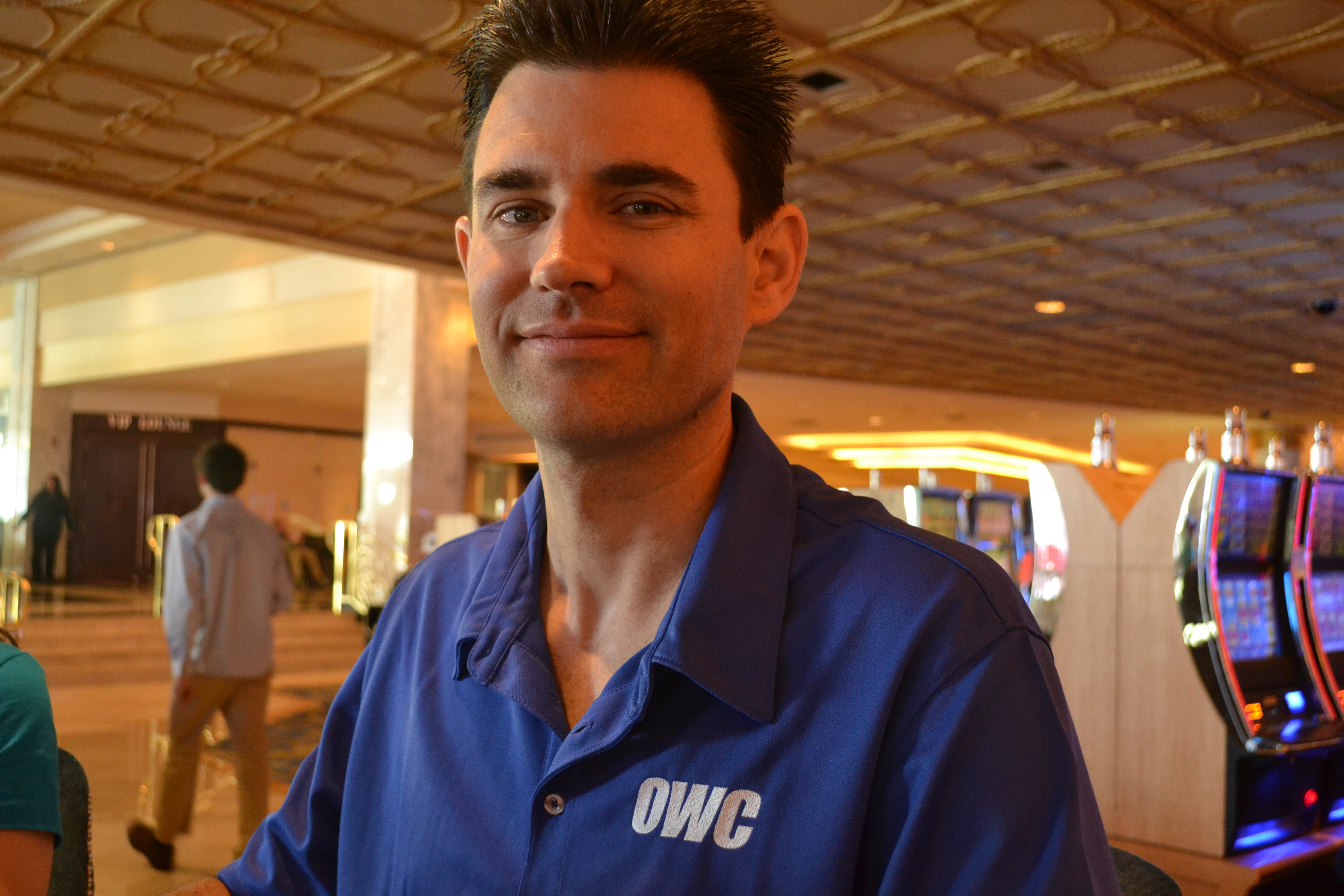
by Lidia Paulinska | May 30, 2016
NAB, April 2016 – OWC is the abbreviation for Other World Computing, one of the longest running 3rd party computer component and storage solutions providers in the personal computer industry. The company started with individual users and small companies and now supports enterprise customers and cloud providers with their products. In a casual and comfortable one on one discussion, we sat down with their CEO and founder to talk about his journey and the company.
It seems like yesterday, said Larry O’Connor, when I asked about his early age of establishing his company. He was 14 years old. Young entrepreneur from Wichita, Illinois. It was in the middle of nowhere – he recalled – “My dad used the computers in his business, he had a TRS 80, so I was exposed to this “staff” in the early age.” He upgraded it.
I do think that was a disruptive business in that time, and I did think I could do it better – he stated.
He recalled, he saw the man coming to their place to do an upgrade on a computer. The technical spent most of his time sitting with the feet on the desk and reading a newspaper. It was then he realized that the paperwork took more time than the effort and process of upgrading the computer. He explained that he then realize, all the folks that need a memory upgrade they don’t need to go to a local computer store. I don’t need to go to the computer store. I can support them and educate them, upgrade it, and even show them how to do it faster and for better price.
In those days, back in the early 1980’s , he found that prices were not changing that quickly and the major computer sale magazines had prices and multiple suppliers for memory, storage and all the accessories. He then found that AOL had an on-line store and chat rooms and an 800 phone number, so his age did not matter, just his knowledge and enthusiasm, to be able sell products. Also, this time was the start of the rise of overnight shipping industry. This was convenient as he could not drive to buy parts or pickup systems for service.
The company started with providing services with known parts going into known computers. He started identifying new components that would improve the performance of the computers his customers had without having them buy a whole new system. He also started to build devices & software that would allow existing parts and peripherals to work with new operating systems and computers.
The driving factor is he cares about the customer, their problems and how to make the computers a productivity tool for them rather than a block in their path they have to put a big effort into learning. He has kept this mentality as the core of the company, and found people with like thinking along the way.
When asked, how did he transition from one person at his parent’s house to running a company that just relocated as they exhausted the local hiring talent pool, he said that he does not feel he runs the company. While people work for him and may report to him, he has to report to everyone at the company and the customers – he is responsible to everyone for what they are doing.
A focus for the company is still on solving customer problems, he sees the future in software to solve problems and expense for customers as well as preserving the value of legacy hardware. He feels that computers and accessories get obsoleted by software applications faster than they stop working and need to be replaced. Software and support can help extend the useful life of a lot of legacy technology for customers at a fair price.
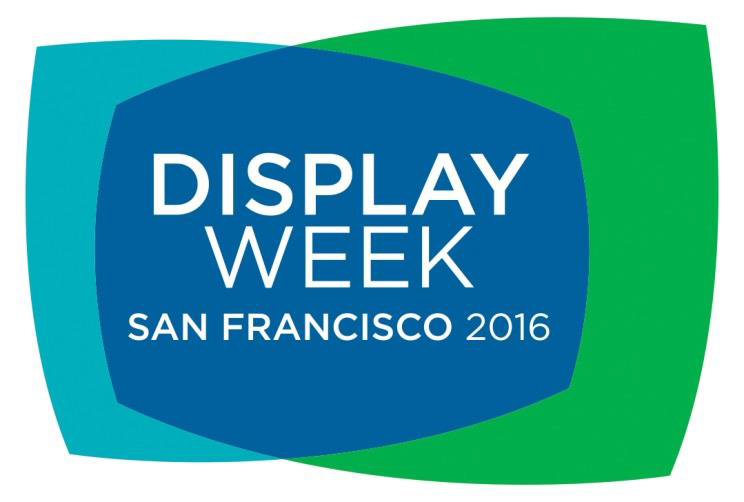
by Lidia Paulinska | May 28, 2016
SID Display Week, May 2016 – Digital signage is used to entice and influence shoppers on their way to the retail stores and shopping malls. Tablets that replacing paper menus, allow restaurant patrons to preview and customize their orders. Engaging visual displays are revolutionizing leisure experiences, promoting increased consumer engagement as e.g. instant replay. Digital signage is a modern communication tool.
At the business session at SID Display Week the presenters: Sanju Khatri, Director of Digital Signage from IHS, Jennifer Davis from Leyard, Karen Robinson from NanoLumens and Paul Apen, Chief Strategy Officer of Eink gave broad overview of digital signage applications that is ambiguous communication tool of our time.
Sanju Khari mentioned needs of outdoor and high-brightness indoor digital signage applications. To address direct sunlight and heat load outdoor displays need to be >2000 nits of brightness, for indoor 1000 nits or higher. Brightness of LCDs can be further enhanced by adding LED backlights and increasing power consumption. However as LED backlights age, they provide fever inputs per watts of power. Cooling mechanisms are essential to maintain lifetime of displays. IP 64 and IP 65 rated. To address harsh and changing weather conditions outdoor displays need to withstand heat, humidity, snow, rain, wind, dust, fumes and dirt. Scratch and impact resistance properties of cover glass is important for both high-brightness indoor and outdoor displays set in high traffic areas. To address heavy usage cycle and vandalism digital signs placed at public settings need additional protection of cover material such as glass or polycarbonate. Important need is also serviceability. Down time of publicly placed outdoor or indoor advertising displays result in negative advertising revenue. Quick turnaround in service and display modules being accessible for on-site repair and maintenance is extremely important.
The Digital Signage market in numbers is growing as well as its revenue:
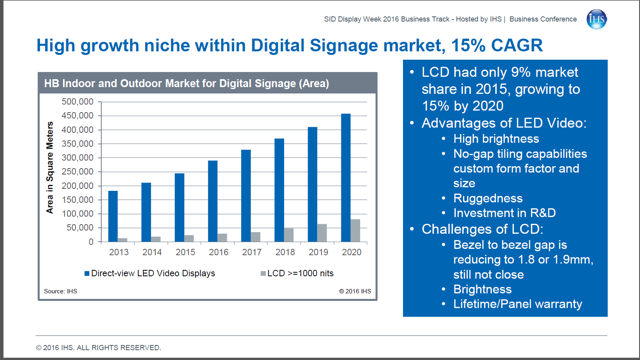
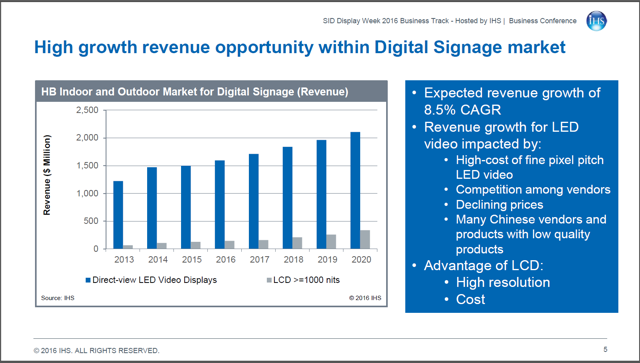
The direct-views LED video displays by pixel pitch in categories of area (square meters) and revenue are portrayed in stats below.
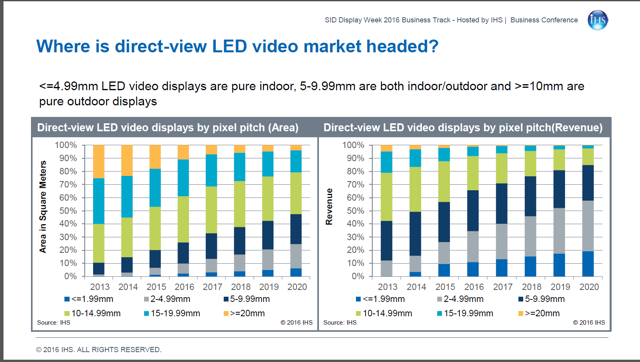
Jennifer Davis from Leyard described the market requirements for digital signage as simple words: Impact and Value – cost effectiveness to the outcome. Those include the features as: seamless (or close to it as they can afford), highly reliable for long-duty cycle applications (all day to 24×7), bright enough and wide enough color to have brand impact, good value.
What are possibilities at LED market?
No doubts that the LED market is expanding, less than 1.9mm pixel pitch grew 279% year in 2015, as well as this area visibility at the related shows such as: ISE, InfoComm China, where more fine-pitch LED offering and vendors were showcasing. The falling costs with the price elasticity makes market growth for LED. Led now is 13% more than rear-projection cubes and 7x the cost of tiled LCD. Down from 200% and 21x two years ago. Davis stated that future grown will be determine by innovations and market maturation.
Karen Robinson from NanoLumens shared her view on current generation that is driven by passion for social media that allows sharing and viewing video. As digital signage is an ambiguous communication tool: displays TV are rising in quality, not just quantity; mobile phone displays continue to improve and Dooh has shifted from vinyl wrapped boards to vibrant LEDs. Display driven generation demands that smartphone and tablet adoption have added new screens. Just as a reminder – in 2000 it was not possible to stream video over a phone. By 2018, over 2.5 billion consumers will enjoy ability to stream video on their smartphones as well as 1.5 billion tablet users worldwide by 2019. Today the average household has 5 or more video-enabled devices. Traditional signage, billboard and display advertising is rapidly shifting to digital and has changing the way we eat, shop, work, play and the way we live. By auto profiling customers and their expected behaviors ahead of their actual presence vendor can quickly customize and personalized the content. Displays become more interactive. Robinson presented few digital displays from worldwide that perfected to create engaging and immersive experiences: American Airlines Arena in Miami, Florida; Holt Renfrew in Ontario, Canada; Mac Cosmetics store in Waikiki, Honolulu, Hawai; Pacific Fair in Broadbeach, Australia; Sport Chek in Toronto, Canada; Telstra in Sydney, Australia and T-Mobile store in New York City, NY. Those examples combine four areas: Architecture, Information, Advertising and Art – she stated.
Paul Apen, Chief Strategy Officer of Eink talked about alternative signage that is ePaper. That display allows outdoor readability, unique form factors and off-grid installations. He stated that it can be used in many areas such as: transportation, conference room, public spaces or retail. The effective signage design should also complement its environment as ePaper does.
Dynamic content management is next thing coming. There will be more relevant content directly to shore, location, and customer. Also economics of the business is allowing the prices to go down. That is the trend now.
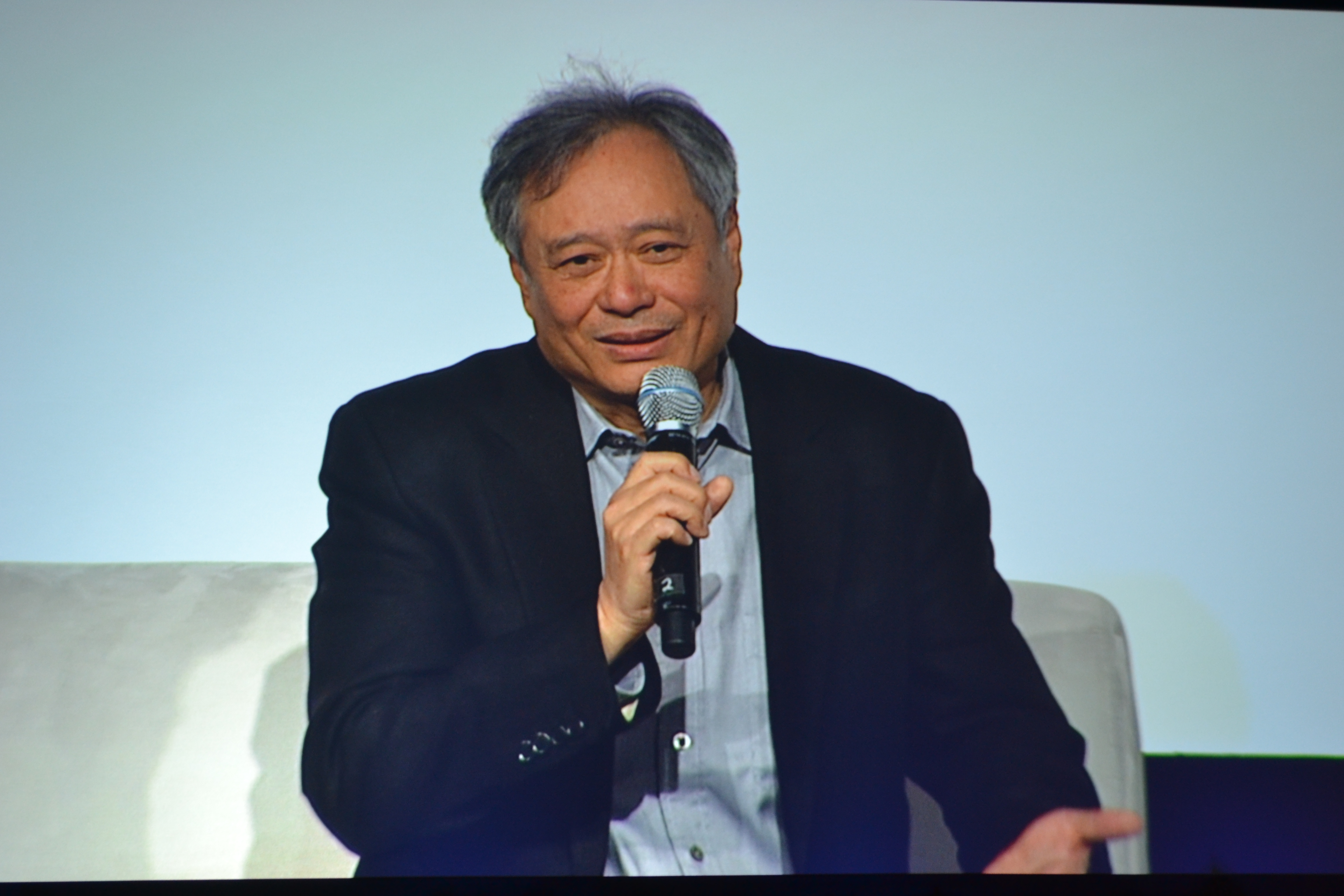
by Lidia Paulinska | May 22, 2016
April 2016, NAB – At the start of NAB, SMPTE held the Digital Cinema Summit. The highlight speaker was Ang Lee who spoke following a discussion that HDR was not a tradeoff for future films, but was a technology that must be adopted due to its benefits in the story telling and immersive aspects of films. He spoke on pushing the limits of cinema.
One of the examples was with his film “Life of Pi”. In this film, the story is the enticing element. One aspect of the story was how to visually represent an irrational number and bring it to the screen as an experience. The film used 3D as an extra dimension in this story telling. HDR and HFR are also new technologies that can help with the story telling. HFR (High Frame Rate) has been under a recent resurgence as an alternative the traditional 24fps, and have been championed at NAB and other events by Doug Trumbull. Doug has been advocating 120fps content for both 2D and 3D films. Doug’s latest workflows include cameras, servers and editing flow for support of 3D, HDR, and 4K all at 120fps.
The workflow has over 40x the data of standard film, but produces an entirely different cinema experience. At NAB they had previews of an 11min clip of Ang Lee’s new film ‘Billy Lynn’s Long Halftime Walk,’ that was shot in 4K, HDR, 3D at 120fps. The preview was shown using dual Christie laser projectors and standard surround sound.
The clip provided an exposure to a new level of a “clarity of image” that has not been seen before by cinema audiences. This clarity of image defines a new challenge for the storyteller to be able to utilize this technology and enhance the story being told. The HFR feature also brings new cinematic capabilities to both 2D and 3D films. The HFR aspect also brings a new level of brightness and smoothness to the playback which can be used to enhance cinematic emotions and action without causing viewer fatigue. The overall common experience of the audience after viewing the clip – mostly related to technology and secondarily the cinematic use of the technology was “WOW!”.
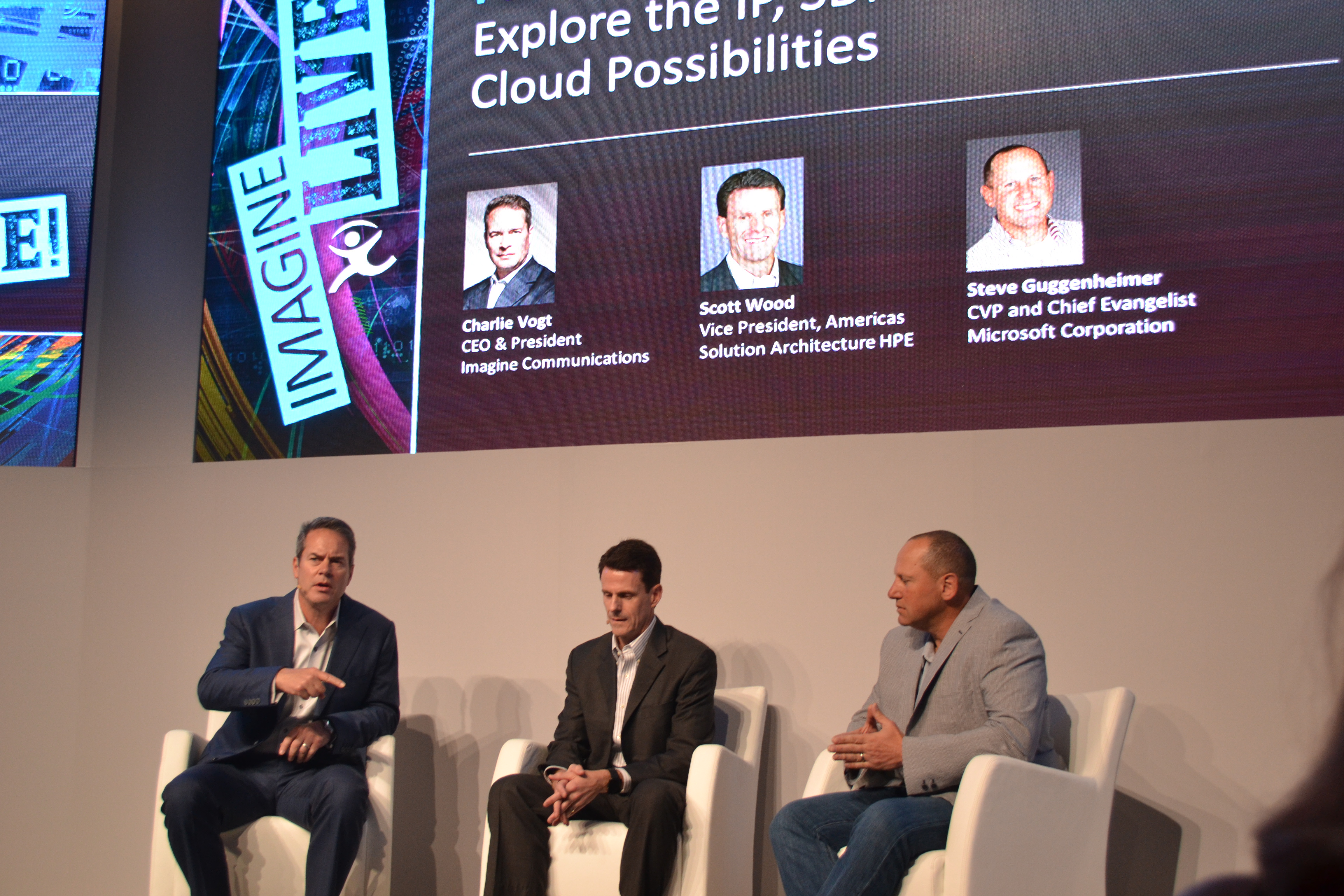
by Lidia Paulinska | May 22, 2016
April, NAB – At the end of the day, the market is more and more competitive and we need our customers not only survive but also thrive – stated Charlie Vogt, CEO of Imagine Communications (IC), moderator of the power session “Transformation 2016: Media Technology Using IP, Cloud and Virtualization”. The session that took place at the Imagine Communications booth during NAB show, was featuring the panelists: Antonio Neri, EVP/GM, Enterprise Group, HPE and Steve Guggenheimer, CVP and Chief Evangelist of Microsoft Corporation.
Cloud-based technologies become more and more popular and there is a less speculation and more interest. But as the technology grows in popularity there is complexity involved. The options to choose from, the providers to select in order to put the pieces together. In the broadcast world everyone knows how complex the market is – stated the panelists – we want to make the complexity understandable. The cooperation between IC, Microsoft and HP Enterprise allow the companies to get full solution and reduce their own risk. So the customer does not need to talk to separate partners. It also to avoid confusion what works together etc. and what is not the best fit.
IC, Microsoft and HP Enterprise provide the leaders innovators solution. Microsoft is platform provider. HP is more cloud broker. Prior to NAB Imagine Communication launched 3 important applications, that required months and months of testing if the new solutions work. As Charlie Vogt mentioned IC and it’s partners goal is their customers to thrive versus not just survive. The reason is the move to the cloud, while necessary is scary, the broadcast community has been on premise for over 50 years, and the change is new.
The discussion included that cloud is a partnership – the tools, workflow, software and support all need to work together to provide the reliability and features of the current solution. As it moves to the cloud the partnership with HPE addresses the security aspects of the Azure cloud which are new to the broadcast community.








